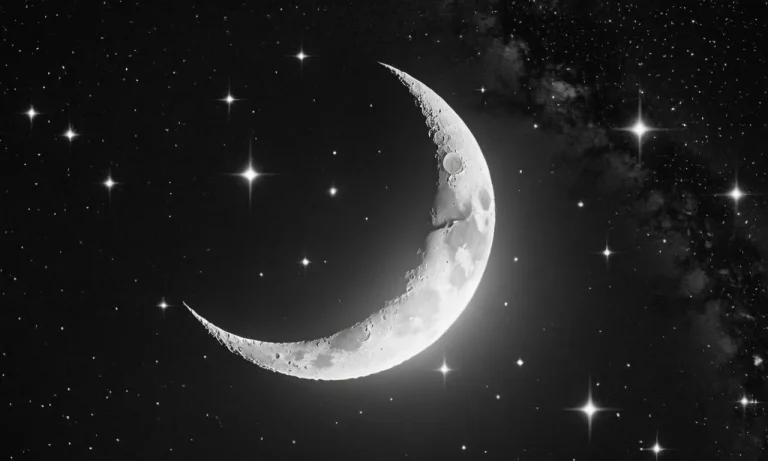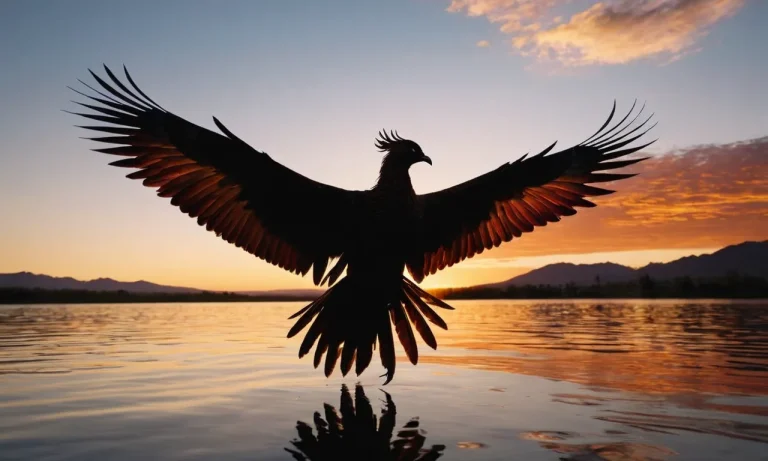Moon dogs are an atmospheric optical phenomenon that manifests as bright spots of light flanking the moon. They have captured people’s imagination for ages and different cultures have ascribed various spiritual meanings to them over time.
In short, moon dogs are generally seen as positive spiritual omens representing hope, rejuvenation, protection, and more. Their appearance has been associated with new beginnings, fertility, safe travel, and happy events.
In this comprehensive guide, we will explore the phenomenon of moon dogs, unpack the symbolism and lore surrounding them across cultures, understand common spiritual interpretations, and uncover why these dazzling lights continue to fascinate us.
What Are Moon Dogs?
Definition and description of the natural phenomenon
Moon dogs, also known as mock moons or paraselenae, are optical illusions that occur when light from the moon is refracted through ice crystals in high-level cirrus clouds. They often appear as bright spots of light on either side of the moon, forming part of a large halo around it.
Conditions necessary for moon dogs to form
The necessary conditions for moon dogs to appear in the night sky are:
- The presence of high altitude cirrus clouds containing hexagonal ice crystals
- The moon being relatively bright, with little competing light pollution
- The ice crystals in the clouds being oriented horizontally
- The observer being located 22° or more away from the moon
When these conditions are met, moonlight entering the ice crystals is refracted at a 22° angle, creating bright spots of light on either side of the moon from the perspective of observers on the ground.
Distinguishing features and appearance
Moon dogs have some distinguishing features that set them apart from sun dogs and halos:
- They appear as part of a much dimmer lunar halo compared to bright solar halos
- Their colors are not as vivid, mostly appearing white or pale yellow
- They are located at roughly the same elevation as the moon
- Moon dogs are often harder to spot due to light pollution near cities and the moon’s weaker light
In optimal dark sky viewing conditions, moon dogs appear as bright smudges of white or yellow light subtly protruding from the left and right sides of a pale 22° halo around the moon.
Moon Dogs in History and Culture
Earliest records of moon dog sightings
References to moon dogs, also known as mock moons or paraselenae, date back to ancient times. The earliest known recorded sighting is from the Chinese historian Gan Bao in the 4th century AD. However, there is evidence that these atmospheric optical phenomena were witnessed and sometimes revered by even earlier cultures:
- Prehistoric petroglyphs found in Burma and Italy resemble strong displays of moon dogs, suggesting they carried spiritual symbolism.
- Passages in the Bible, Rigveda, and Homeric poems contain descriptions resembling moon dogs, portraying them as awe-inspiring celestial events.
Prominence in Norse mythology and Vikings
Moon dogs had particular importance for Norse and Viking culture, seen as mystical signals tied to gods and fate:
- They were linked to Sköll and Hati, wolves in Norse mythology that were chasing the Sun and Moon. When the wolves came close, it was believed moon dogs would appear as a warning.
- Vikings saw them as part of navigational guidance from the gods. There was a Viking saying “When you see the dogs, land is near.”
Symbolism in Native American culture
For North American tribes, moon dogs carried various symbolic meanings:
- A Potawatomi myth links moon dogs to warriors rising to high positions in the tribe.
- The Cree considered them the reflection of spirits dancing in the skies.
- The Cheyenne saw them as a sign of hard times and hunger ahead.
Importance in Asian folklore
In parts of Asia, cultural lore often focused on the auspiciousness of moon dogs:
- Chinese traditions claimed seeing one moon dog meant good luck, while three had special protective meaning.
- In Mongolia they were thought to fortify against evil spirits. Children were sometimes brought outside to witness them.
- According to Himalayan legend, divine birds with the heads of dogs flew across the sky near the source of the Ganges river.
Depictions in art and literature over time
Moon dogs have inspired creative depictions for millennia. Early rock paintings, petroglyphs, and ruins show them prominently. They are also found in paintings, books, coins, flags, and national emblems:
| 5th century BC | Appears on coinage of Greek colony Selinus in Sicily |
| 12th century AD | Illustrated in Tamil Indian text Vigyanan’s View of Nature |
| 1535 AD | Prominent in English stained glass Works of Henry VIII |
| 1876 AD | Featured on the flag of Kyrgyzstan |
| 1937 AD | Described in realist fiction novel The Moon is Down by John Steinbeck |
Common Symbolic Meanings of Moon Dogs
Representing hope and renewal
When moon dogs appear in the night sky, many cultures see them as a sign of hope and renewal. Just as the cycles of the moon represent renewal, rebirth, and new beginnings, the unexpected appearance of moon dogs can signify that positive change is coming.
Some Native American traditions believed that moon dog sightings foretold the birth of an important leader, representing hope for the future.
Signifying protection and guidance
In Inuit mythology, moon dogs were seen as protective guardians watching over the people. Their presence in the sky was believed to offer guidance and ward against harm. When the cold arctic winds blow and food is scarce, spotting moon dogs surround the moon meant the spirits were protecting the tribes and would help provide for them in the harsh winter months.
Indicating fertility and abundance
In Chinese culture, moon dogs were connected to fertility and productive harvests. As parhelions often take on rainbow colors, legends tied these small rainbows around the moon to the goddess Yutu who watches over female fertility.
Moon dog sightings were seen as Yutu bringing good blessings for babies and fruitful harvests ahead. Around the moon, these rainbow rings forecasted prosperity and abundance.
Foretelling positive events and good fortune
Some European folk tales interpret the appearance of moon dogs as heralding good fortune. Whether bright wedding days ahead, news of a baby on the way, success in future journeys or endeavors, or just a general omen of luck, many myths link moon dogs to positive events unfolding for those who spot them.
Since they often appear in cold seasons, they can signify that brighter days are coming soon, both literally with the spring thaw or metaphorically with the good news they foretell.
Symbolizing the value of community and relationships
In various Native American stories, the rainbow colors of moon dogs were connected to themes of community, kinship, and relationship. Just as a rainbow unites all colors, the presence of these small rainbow rings around the moon served to remind tribes of the significance of togetherness.
Moon dogs encouraged strengthening clan ties, harmony between families, and peace among all people.
| Moon Dog Meaning | Culture |
|---|---|
| Hope and renewal | Native American |
| Protection and guidance | Inuit mythology |
| Fertility and abundance | Chinese culture |
So while the celestial light phenomena may have a scientific cause, throughout history moon dogs have signified joyous omens, fortunate blessings, vital guidance, and hopeful new beginnings. These special sundogs have inspired many meaningful legends and enduring cultural symbolism about life’s bright possibilities.
Spiritual Interpretations and Beliefs About Moon Dogs
Thought to be messages from deities and spirits
In some spiritual traditions, the appearance of moon dogs is believed to signify divine messages or guidance from deities, ancestors, or animal spirits. For example, in Native American culture, the Zuni tribe sees moon dogs as scout wolves sent by the wolf deity to watch over night travelers.
The number and brightness of the moon dogs may impart wisdom about one’s path ahead.
Viewed as guardians watching over night travels
Linked to the idea of moon dogs as spirit messengers, many cultures recognize them as protectors and guides for night journeys. The Cree people call moon dogs the “campfires” of the Creator, lighting the way through darkness. Spotting moon dogs before traveling at night is often seen as good fortune.
Seen as heralds of transformation and new cycles
For pagans and Wiccans, the cycles of the moon hold deep meaning, so the appearance of moon dogs can signify coming change or transition. As extensions of moonlight, they may announce the ending of one life season and the dawning of a new phase of growth.
Their fertilizing light calls us to plant new seeds – emotional, spiritual, or physical.
Believed to call attention to balance and harmony in life
Since moon dogs often appear in symmetrical pairs on either side of the moon, many philosophies recognize them as representations of equilibrium and unity between opposing forces – light/dark, known/unknown, self/other.
Catching sight of them is seen as a reminder to nurture balance and wholeness in one’s life.
Considered an invitation for contemplation and awareness
Rare and dazzling to behold, moon dogs awaken feelings of awe and activate a sense of mystery in the night sky. So in many indigenous outlooks, their appearance serves as a call to stillness, inward focus, and contemplation.
If we pause to wonder at their beauty, they reawaken our instinct for reverence, sharpen our perception, and heighten our awareness of unseen realms.
Why Moon Dogs Continue To Captivate Us
Representing mystery and liminality
Moon dogs have captivated humanity’s imagination for ages, often representing the mysterious and liminal in nature. These luminous night sky phenomena occur when sunlight refracts through ice crystals in cirrus clouds at specific angles, creating bright spots 22° to the left and right of the moon (EarthSky).
Their ethereal quality evokes something numinous and not fully graspable by the rational mind. Cultural anthropologist Victor Turner used the term “liminal” for such in-between states that defy simple categorization. Moon dogs seem to inhabit an interstitial zone outside everyday reality.
Evoking awe of natural phenomena
Part of what draws us to moon dogs generation after generation is the sense of wonder they evoke. As relatively rare and fleeting meteorological phenomena, they serve as a reminder of nature’s grandeur and ability to surprise.
Their chance configurations appear specially arranged just for the observer. According to psychologists Keltner and Haidt’s awe model, wondrous events that defy expectations force us to revise our mental schemas. By evoking awe, moon dogs may expand our consciousness beyond habitual patterns.
Reminding us of things greater than ourselves
Gazing at moon dogs can foster feelings of humility, reminding us of powers exceeding our control. We realize how small we are compared to the immensity of interstellar space and cycles of ice ages and global climates of which moon dogs are a trace.
Philosopher Immanuel Kant saw sublime phenomena like moon dogs as evidence of man’s dual nature – physical insignificance yet also spiritual transcendence of mere material existence through our faculties of reason and aesthetic judgment.
Symbolizing unity between earth and sky
Many cultures have viewed astronomical events like moon dogs as forming a bridge between the heavens and our world below. Astrophysicist David Levy notes several Native American traditions believing the Creator placed spirits as guardians at these celestial gateways.
Contents of the macrocosm could flow into the microcosm and vice versa. In this cosmology, phenomena were interpreted as signatures of an interconnected cosmos, with reciprocal exchanges between inner and outer realities.
Stirring collective imagination across cultures
From Arctic indigenous peoples to Ancient Greco-Roman civilizations, moon dogs have fired our collective imagination over the centuries. Early skywatchers incorporated them into their mythic cycles and seasonal rituals as magical portents.
Greek and Roman literature abounds with references to sun dogs and moon dogs as everything from ominous war harbingers to the chariot of Artemis. Later Western interpretations often imbued them with spiritual symbolism of the Three Magi attending the nativity.
These shared meaning-making processes around sublime sky spectacles arguably fulfilled psychological needs and strengthened cultural cohesion. Even in today’s more rationalistic society, moon dogs still inspire flights of fancy and connect us to the ongoing stream of human stargazing.
Conclusion
The stunning lights of moon dogs have enthralled people for millennia and been imbued with rich symbolic significance across many cultures. While the science behind them is now understood, their splendor continues to evoke a sense of magic, possibilities, and connection to forces greater than us.
The various interpretations tied to them – from representing cherished hopes to foretelling bright futures – reveal the profound need we humans have to make meaning of the world around us. In many ways, the allure of these ‘spirit dogs’ reminds us that while we have come a long way in demystifying nature through science, its dazzling beauty shall continue to fill our hearts with eternal wonder.






